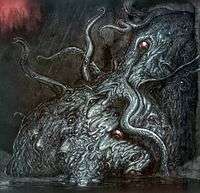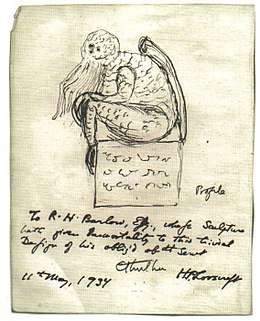Shoggoth
A shoggoth (occasionally shaggoth[1]) is a monster in the Cthulhu Mythos. The beings were mentioned in passing in H. P. Lovecraft's sonnet cycle Fungi from Yuggoth (1929–30) and later described in detail in his novella At the Mountains of Madness (1931).[2]
| Shoggoth | |
|---|---|
| Cthulhu Mythos character | |
 An artist's rendition of a shoggoth. | |
| First appearance | At the Mountains of Madness |
| Created by | H. P. Lovecraft |
| In-universe information | |
| Alias | Shaggoth |
Description
It was a terrible, indescribable thing vaster than any subway train—a shapeless congeries of protoplasmic bubbles, faintly self-luminous, and with myriads of temporary eyes forming and un-forming as pustules of greenish light all over the tunnel-filling front that bore down upon us, crushing the frantic penguins and slithering over the glistening floor that it and its kind had swept so evilly free of all litter.
— H. P. Lovecraft, At the Mountains of Madness
The definitive descriptions of shoggoths come from the above-quoted story. In it, Lovecraft describes them as massive amoeba-like creatures made out of iridescent black slime, with multiple eyes "floating" on the surface. They are "protoplasmic", lacking any default body shape and instead being able to form limbs and organs at will. A typical shoggoth measures 15 feet across when a sphere, though the story mentions the existence of others of much greater size. Being amorphous, shoggoths can take on any shape needed, making them very versatile within aquatic environments.
Cthulhu Mythos media most commonly portray shoggoths as intelligent to some degree, but deal with problems using only their great size and strength. The shoggoth that appears in At the Mountains of Madness simply rolls over and crushes numerous giant penguins that are in its way as it pursues human characters.
The character Abdul Alhazred is terrified by the mere idea of shoggoths' existence on Earth.
The shoggoths bear a strong physical resemblance to Ubbo-Sathla, a god-like entity supposedly responsible for the origin of life on Earth.
Fictional history
At the Mountains of Madness includes a detailed account of the circumstances of the shoggoths' creation by the extraterrestrial Elder Things. Shoggoths were initially used to build the cities of their masters. Though able to "understand" the Elder Things' language, shoggoths had no real consciousness and were controlled through hypnotic suggestion. Over millions of years of existence, some shoggoths mutated, developed independent minds, and rebelled. The Elder Things succeeded in quelling the insurrection, but exterminating the shoggoths was not an option as the Elder Things were dependent on them for labor. Shoggoths also developed the ability to survive on land, while the Elder Things retreated to the oceans. Shoggoths that remained alive in the abandoned Elder Thing city in Antarctica would later imitate their masters' art and voices, endlessly repeating "Tekeli-li" or "Takkeli",[3] a cry that their old masters used.
Other appearances
Aside from their main appearance in At the Mountains of Madness, shoggoths appear in numerous other Mythos stories, often as servitors or captives to powerful cults and entities.
- Shoggoths are mentioned in the Lovecraft short stories "The Shadow over Innsmouth" (1931) and "The Thing on the Doorstep" (1933).
- Shoggoths appear in both the Chaosium and the Wizards of the Coast Call of Cthulhu role-playing game supplements.
- Shoggoths are featured in Charles Stross' "A Colder War" and The Atrocity Archives, in which they are weapons of mass destruction.
- Elizabeth Bear's novelette "Shoggoths in Bloom" explores the themes of volition and slavery suggested by the shoggoth origin.
- A shoggoth appears in the graphic novel Nemo: Heart of Ice by Alan Moore and Kevin O'Neill, a spin-off from The League of Extraordinary Gentlemen.
- Shoggoths play a prominent role in Edward Lee's 2009 novella Haunter of the Threshold.
- A shoggoth appears in the video game Call of Cthulhu: Dark Corners of the Earth, where it lurks in the sewers of Innsmouth.
- A mini-boss in the video game Darkest Dungeon, itself borrowing heavily from Lovecraft in both tone and gameplay, is called a Shambler, and is a fairly direct replication of the shoggoths from In the Mountains of Madness, which are referred to by the author as "shambling".
- Shoggoths appear in the penultimate and final novels of Edward M. Erdelac's weird western series Merkabah Rider.
- A shoggoth appears in the graphic novel War Cry by Jim Butcher, part of his The Dresden Files continuity.
- Shoggoths are enemies in the independent game Eldritch, by Minor Key Games.
- Shoggoths appear in Robert Bloch's short story "Notebook Found in a Deserted House" that was published in the May 1951 edition of Weird Tales.
- Shoggoths are featured in Move Under Ground, a horror novel mashup by Nick Mamatas.
- The gelatinous creatures which emigrate to the UK in Ben 'Yahtzee' Croshaw's novel "Differently Morphous" are initially referred to as "shoggoths" until the term becomes identified as a racial slur against fluidic beings.
- Shoggoths appear in the video game Celeste.
- Shoggoth-like creatures appear in the manga Berserk, by Kentaro Miura, as the snail/amoeba-like "whiskers", or fingertips of the giant jellyfish/octopus-like (Cthulhu-like) Sea God.[4]
- Shoggoths are one of the monsters that appear at 'Dimensional Gates' in the board game Arkham Horror.[5]
- Shoggoths are the monsters that appear in the board game Pandemic: Reign of Cthulhu (2016)[6]
- The Shoggoth also appears in the Minecraft mod "AbyssalCraft".
- The Shoggoth also appears as a maid creature in Kenkou Cross's Monster Girl Encyclopedia. While more pleasing to look at, it retains a number of features of the original Lovecraftian version.[7]
Shoggoth are mentioned in the conclusion of the story The Temple of Abomination by Robert E. Howard.
See also
Notes
- This spelling appears in the original Arkham House printing for "The Thing on the Doorstep" (1937 or shuggoth), though the definitive manuscripts show that the proper spelling is in fact "shoggoth". (Burleson, H. P. Lovecraft, A Critical Study, footnote #14, p. 195.)
- Joshi, S.T.; Schultz, David E. (2004). An H.P. Lovecraft Encyclopedia. Hippocampus Press. pp. 9–13. ISBN 978-0974878911.
- This cry is a reference to the Edgar Allan Poe novel The Narrative of Arthur Gordon Pym of Nantucket, which is cited in At the Mountains of Madness. (Pearsall, "Poe, Edgar Allan", The Lovecraft Lexicon, p. 332.)
- Miura, Kentaro (2012). Berserk, Vol. 36. Japan: Dark Horse Manga; 1st edition. p. 5. ISBN 978-1595829429.
- {https://boardgamegeek.com/boardgame/15987/arkham-horror}
- {https://boardgamegeek.com/boardgame/192153/pandemic-reign-cthulhu}
- Cross, Kenkou (September 26, 2017). Monster Girl encyclopedia. Volume II. Fray, Harriet,, DK. [Los Angeles, California]. ISBN 978-1-62692-609-7. OCLC 1010497056.
- Name may translate to "native of" (oth) "realm of darkness" (shogg)
References
- Burleson, Donald R. (1983). H. P. Lovecraft, A Critical Study. Westport, CT / London, England: Greenwood Press. ISBN 0-313-23255-5.
- Harms, Daniel (1998). "Shoggoths". The Encyclopedia Cthulhiana (2nd ed.). Oakland, CA: Chaosium. pp. 273–4. ISBN 1-56882-119-0.
- Lovecraft, Howard P. (1985) [1931]. "At the Mountains of Madness". In S. T. Joshi (ed.). At the Mountains of Madness and Other Novels (7th corrected printing ed.). Sauk City, WI: Arkham House. ISBN 0-87054-038-6. Definitive version.
- Pearsall, Anthony B. (2005). The Lovecraft Lexicon (1st ed.). Tempe, AZ: New Falcon Pub. ISBN 1-56184-129-3.
- Kenkou, Cross (2016). 魔物娘図鑑Ⅱ(Monster Girl Encyclopedia II). Seven Seas. p. 166. ISBN 978-1626926097.
